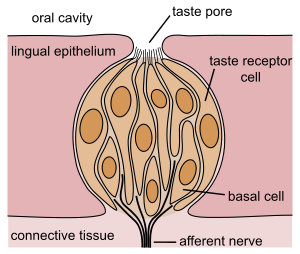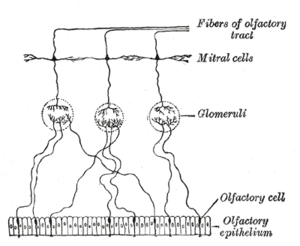Chemoreceptors
Chemoreceptors are composed of Olfactory Receptors and Taste Receptors.
Taste Receptors[edit | edit source]
The taste organs are the Taste Buds. They are spherical bodies composed of epithelial cells with a lighter cytoplasm (compared to surrounding epithelial cells). These cells rest on the basal lamina, with most of them reaching the surface of the epithelium. The sensation of taste is perceived by secondary receptor cells. Taste receptors are mostly located on the tongue, but also appear at soft palate and laryngeal surface of the epiglottis.
- Taste buds are found lining the circumvallate and the fungiform papillae. We can see 4 types of cells in them:
- Type I: These are the most numerous. They are the supporting elements of the taste buds. They are tall, with lots of microvilli at the apical portion, rest on the basal lamina and reach the taste pores. Their cytoplasm contains electron dense granules with glycosaminoglycans.
- Type II: Also contain microvilli. They have a conspicuous cytoplasm, with voluminous smooth endoplasmatic reticulum. Their function is unknown.
- Type III: A secondary receptor cell, they have afferent nerve endings found near the base. They are tall, with vesicles (40-60 nm in diameter) in their cytoplasm, and microvilli apically.
- Type IV: small, undiferentiated cells basal cells. They are the precursors of the other types.
Olfactory receptors[edit | edit source]
Specialized bipolar neurons with highly modified dendrites. They are located in the olfactory epithelium at the roof the nasal cavity. They are arranged as specialized pseudostratifed columnar epithelium.
Composed of 3 cells:
- Olfactory Cells: Modified bipolar neurons, ocurring among basal and supporting cells. At their apical spherical portions, there are long, nonmotile cilia responsible for detection of odoriferous substances. These cilia are arranged along the surface of the olfactory epithelium in a layer of fluid secretion that covers the entire epithelial surface. At the base of the olfactory cells, axons arise and converge in bundles heading to the central nervous system.
- Supporting Cells: Have broad cylindrical portions and narrow bases. At the apical portions, they have microvilli. They contain a light yellow pigment (responsible for the special colour of the mucosa) in the cytoplasm,
- Small Basal Cells: Form a single layer at the base of the epithelium.
PAULSEN, Douglas F. Histology and Cell Biology. 5th edition. McGrawHill, 2010. 359-360 pp. ISBN 978-007-107871-9.


